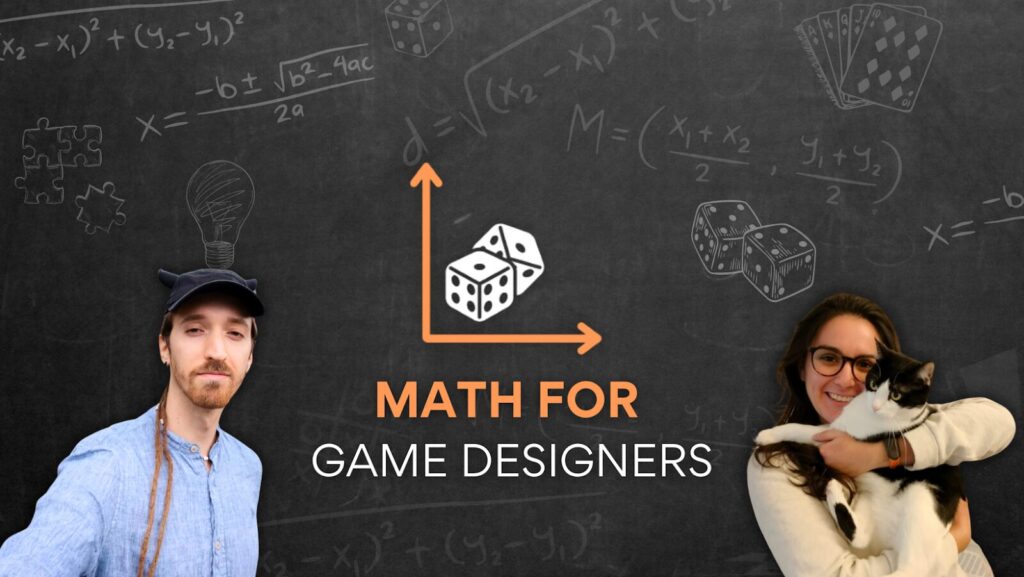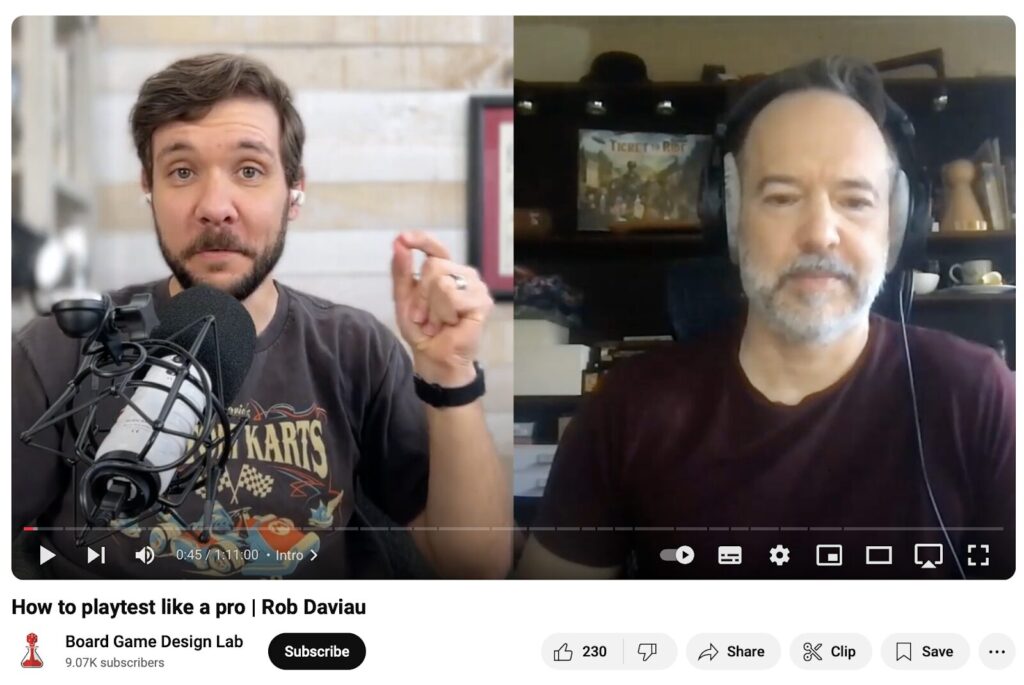This one is a super special post. We go deep into the realms of in-game mathematics with the wonderful folks from Math for Games designers. Make sure you check out their work on instagram, and if you have a game you want ‘mathsing’ (new word) get in touch with them.

Joe: Thanks for joining me on the blog. I’m excited about our conversation, but first can you tell us a little about who you are and what brings you to the world of board games?
Michele: Thank you Joe for having us and for the interview! My name is Michele Piccolini. I’m a board game designer, but my background is in physics and data science, and I also studied to be a video game developer.
In my work as a game designer (titles I worked on: Wonder Book, Ryozen, Rumblebots) I often use my mathematical knowledge, even if only unconsciously, and I would like certain tools to be shared and available to all game designers, even those who do not come from a scientific/quantitative background.
Maria Chiara: Hi, I am Maria Chiara Bagli and I received my master’s degree in mathematics. After graduation I dedicated myself to game design and developed some games for Android. Since this year I am also dedicated to bringing games to elementary schools. I also started writing some “mateludic” analysis articles on the blog “Giochi sul nostro tavolo” where I analyzed some modern games from a mathematical point of view.
We work at the intersection of game design and mathematics, believing that modern game design can benefit tremendously from a more mathematical and quantitative approach.
Together we are Math for Game Designers, a duo dedicated to improving game design through the use of mathematics. We work at the intersection of game design and mathematics, believing that modern game design can benefit tremendously from a more mathematical and quantitative approach. We have several ongoing projects and initiatives: from our social pages, where we offer contributions and mathematical pills for as wide an audience as possible, to books we are writing on the topics in question. You can find us at @mathforgamedesigners on instagram or at our web site https://www.mathforgamedesigners.com/ .
Joe: Thanks for the intro. Can you explain why you think maths and mathematical analysis of games is important?
Math for Game Designers: Mathematics can be an incredibly useful tool to streamline various stages of development. The most commonly recognized application of math is in balancing, but it can also play a crucial role during playtesting and even in the initial design phase. Typically, math is associated with probability and game theory, but its usefulness extends far beyond that. For example, graph theory can be applied to the layout of game boards, logic can be employed in social deduction and mystery games, topology can be used to design maps and tracks, calculus and simulations are fundamental to analyze data and trends, solve optimization problems, and balancing. In addition to its role as a powerful analytical tool, math can also serve as inspiration! There are several examples of games that were inspired by some aspect of mathematics, such as Vektorace, a racing game with vector-based movement, or Charty Party, a party game where you guess charts, or IQ Digits, a puzzle game where you have to fit digits into a small board, and many more!
Joe: There’s so much to explore, I hadn’t thought about something like layout of board in a mathematical way before. I’m a big fan of maths – can you tell me what you love about exploring the maths of games, why does this topic get you going?
Math for Game Designers: Mathematics can be looked for anywhere, and history teaches us that games are intertwined with mathematics. Often we associate mathematics with “classic” games, but we are convinced that there is so much to discover in modern ones as well. That is why in our posts we often analyze and take inspiration from modern board games, from Euro games, to card games, to even party games! What drives us is definitely the curiosity to discover mathematics in game design.

We want to show how much of this discipline is hidden in many games. Moreover, we are convinced that the study of how it can be used in game design can be really useful during the development of a game. That is why we address game designers and we try to provide useful information and techniques that everyone can use. Lastly, mathematics for game design is rarely seen as a subject of study; we hope that our approach can help change this perception as well.
Joe: I love that you’re striving to support games designs to create better games through this work! For those of us without a mathematical background, can you think of a good, beginner aspect to start with in our games?
Math for Game Designers: For designers with little mathematical background, we recommend you start learning about combinatorics. For example, what is the difference between permutations , partial permutations and combinations . This is the mathematics of “counting”, and it can help you answer questions such as “how many cards or symbols do I need in my game?”.
Another recommendation is probability. Learning about events , random variables , distributions , expected values and variance will give you the tools to reason about the random aspects of your game and help you balance outcomes like card and dice draws.
Finally, a third “pillar” you should read something about is game theory. It can be valuable to know what are sequential (and simultaneous) games, what is perfect (and imperfect) information, and what are random (and deterministic) games (see this), as well as what are the very famous Nash equilibria .
Joe: I’ll certainly look into this. I think I remember some of it from Uni many years ago, and I’ve seen a Beautiful Mind so that means I’m at least half aware of Nash! There’s a lot of ideas going on here!
Math for Game Designers:: You don’t have to learn all these concepts at once, nor force yourself to use them! But if you know about them, you will acquire the terms to talk about your game in a more analytical manner, which greatly helps communication (for example, with a co-designer or a publisher!) and the “lenses” through which you can analyze and break down your game. The opportunities to employ this knowledge will arise naturally, as you learn more and more!
Oftentimes, even unexpectedly, you will find that some branch of mathematics can be relevant for your game.
Also when there is a problem try to ask yourself, “Could math help me in this?” even if you are developing a party game in which not a single number is present! Oftentimes, even unexpectedly, you will find that some branch of mathematics can be relevant for your game – such as graph theory in a game like Pandemic, or logic in a game like Love Letter – and can help you in your development.
Joe: Maths is such a cool tool for really honing a game. I know a few designers who would shy away from the maths, and focus more on how a game feels, making adjustment more intuitively. What’s your thoughts on leaning into the “feels” of a game, and away from the maths? Is that something to be wary of – I imagine that sometimes, particularly with probability, our intuition can let us down.
Math for Games Designers: There’s nothing wrong with balancing a game by relying on intuition, but there are a few important steps that can help avoid common pitfalls.
Being a solid player overall—and particularly skilled at your own game—is essential. Much of balancing is identifying overpowered or dominant strategies and toning them down. One common trap is relying too much on “feel” without recognizing personal biases or skill limitations, which can lead to exaggerating the importance of certain elements. In a recent post, we discussed one of the most common biases in game design: loss aversion.
If you aren’t the top player in your game (spoiler: as a designer, you rarely will be), extensive testing and data collection are critical. Applying statistical analysis helps you interpret results objectively, preventing misinterpretation due to limited data or lack of a clear framework on how to process it. We highly recommend this talk by Rob Daviau, co-creator of Pandemic Legacy, on How to Playtest Like a Pro.

Finally, taking a more mathematical approach can help keep things in check. Techniques like establishing a “value” for each element in the game can guide you towards the appropriate power levels. We cover this approach in our posts on individual balancing (pt 1, pt 2, pt 3) and look forward to expanding on this topic in future posts!
Joe: Thanks for all of this, it’s super insightful. Let’s finish off with a final bit of maths – what’s the coolest maths-related thing you’ve found when exploring the maths of games design?
Michele: One thing I find definitely fascinating is the fact that, in game theory, when modeling a sequential game (a game where players take turns), the way to model chance is to pretend it’s another player, called Nature, who can take several decisions (the various possible outcomes of a random event, such as the roll of a die), opening new branches in the game tree! Isn’t that evocative?
Maria Chiara: I found it mind-blowing to discover that an unusual branch of mathematics like the projective plane is present and fundamental in a simple game like Dobble. Who knows what else connects mathematics and game design!
Told you that was going to be wonderful and special. Find Michele and Maria Chiara on Instagram and make sure you say ‘hi’. Then subscribe to the What If blog for more incredible conversations about all things games design.



Hi, I’ve never heard of this team and the article is fascinating! Thanks so much. I’m off to find them on instagram.